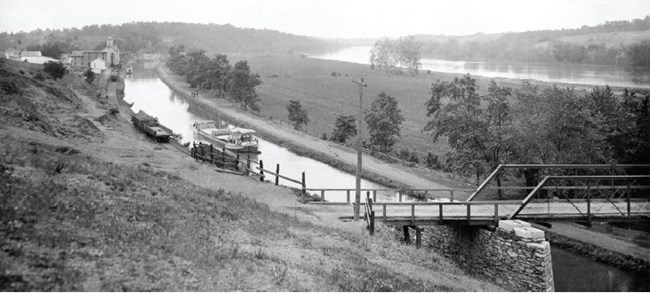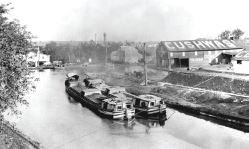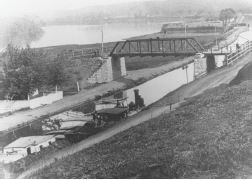
NPS Photo The confluence of the Potomac River and the Conococheague Creek have long been used for transportation – first by American Indians and later by European settlers who moved into the area. In 1787, Revolutionary War hero General Otho Holland Williams founded Williams Port. Realizing that these two waterways created the ideal opportunity for commerce, Williams concentrated on promoting his town as a transportation hub. The arrival of the Chesapeake and Ohio Canal in 1834 brought a period of prosperity and provided a new trade route between Cumberland and Georgetown. Commerce thrived here with two warehouses built along the canal, making Williamsport an important coal transfer point. Though Williamsport’s time as a transportation hub and industrial center has passed, the town continues to retain its character today as a classic canal town. Walk the C&O Canal Towpath as it passes through Williamsport and visit the remaining canal features. Starting in the Cushwa Basin and walking to Lock 44 and back is a walk of one and a half miles that along the way provides a glimpse into the history of this Canal Town. 
NPS 
NPS Photo Cushwa WarehouseOperated by Victor Cushwa and his descendants, the Cushwa Warehouse dealt in coal, brick, flour, iron, cement, and plaster which supported the economy of Williamsport and surrounding Washington County. The coal transferred from here to Hagerstown and further inland during the canal years made Williamsport a prosperous community. The warehouse remained as main office for the Cushwa company until early 1970s. In 1974, the National Park Service purchased the warehouse. Today the Cushwa Warehouse has exhibits about the history of Williamsport and has some original artifacts from the Cushwa company. Trolley Barn Power StationIn 1896, the Hagerstown Railway Company built the first electric trolley line in Washington County, running from Williamsport to Hagerstown. Water from the Conococheague Creek and coal from the Cushwa Warehouse made this location ideal for a steam-powered generating station. However, the power generating station only operated for about two years. The popularity of the trolley required more cars and more electricity, so a larger power plant was built in Hagerstown. This building was then used as a warehouse by the trolley company and later by the Cushwa company. In 1974, the National Park Service bought the Trolley Barn. Today, the Trolley Barn has information about the construction and operation of the canal. Conococheague AqueductAqueducts are water bridges that carry canal boats over creeks and rivers. Completed in 1835, the Conococheague Aqueduct is the fifth of eleven such structures on the C&O Canal. It consists of three equal 60’ arch spans extending 196’ between abutments. Unfortunately, in April 1920 a canal boat broke through the upstream wall of the aqueduct, shutting down the canal for over four months. Repaired with a timber wall this aqueduct functioned until the canal for good in 1924. In 2019, the National Park Serviced rewatered the Conocochegue Aqueduct restoring it to its 1920 appearance. Today, the Conocochegue Aqueduct is the only operable aqueduct on the C&O Canal. Railroad Lift BridgeBuilt in 1923 by the Western Maryland Railway, the railroad lift bridge is one of several one-of-a-kind features on the C&O Canal. Operating like an elevator, this structure lifted the railroad tracks to allow canal boats to pass beneath. The tracks, for transporting coal, led to the power plant between the river and the canal. In 1924, the C&O Canal closed making the lift bridge unnecessary. In 2016, the National Park Service raised the bridge to allow guided boat tour traffic. Today, the lifted bridge allows access to the canal towpath via a wooden staircase. 
NPS Photo Bollman BridgeThe Bollman Bridge, also known as Salisbury Street Bridge, is a motor and pedestrian bridge over the canal. Designed in 1879 by civil engineer Wendell Bollman, a pioneer in engineering of iron bridges, this this single span “Pratt Truss” design bridge measuring 67 feet long and 13.3 feet wide. This is the only remaining bridge built by Bollman on the C&O Canal. Today, the bridge allows for cars to connect to River Bottom Park. Lock 44 & LockhouseSeven days a week, 24 hours a day, in all weather, lockkeepers attended to canal traffic. Lockkeepers were responsible for opening and closing the 74 lift locks along the canal. A lift lock works like a water elevator, raising or lowering a boat 8 to 10 feet. The lockkeeper was given a salary, a lockhouse, and an acre of land for livestock and a garden. Lockhouse 44 is one of little more than a dozen surviving lock houses on the C&O Canal and remains as evidence of a bygone way of life. Harvey Brant, the last lockkeeper at Lock 44, operated the lock from 1915 - 1924. The Brant family left in 1961, decades after canal ceased operations. Today, the lockhouse has been restored and the interior is furnished as it would have been in the 1920s. |
Last updated: January 9, 2025
